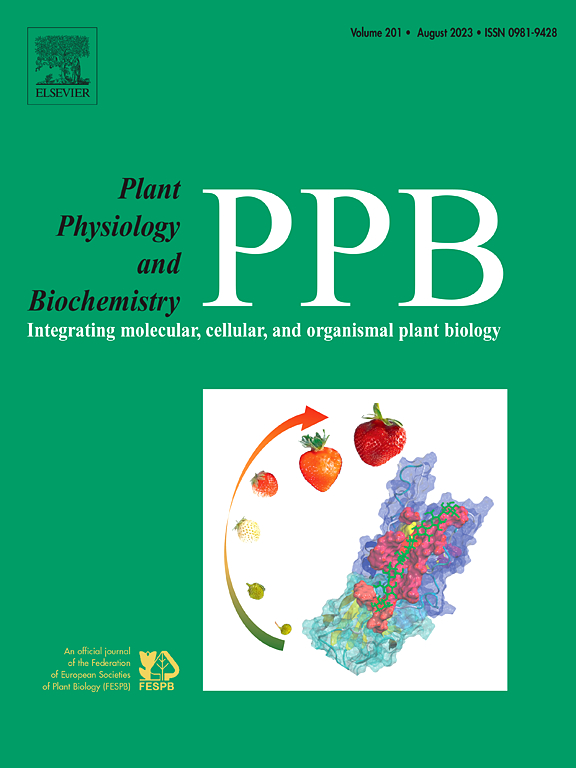Rhizosphere ecology and physiological regulation drive cadmium accumulation efficiency in Hylotelephium spectabile populations
IF 6.1
2区 生物学
Q1 PLANT SCIENCES
引用次数: 0
Abstract
Understanding the rhizo-ecological characteristics and physiological responses to Cd stress provides insight into the intrinsic Cd accumulation mechanisms of Hylotelephium spectabile. Under Cd exposure, the LN population exhibited a growth advantage over HB, attributed to Cd-induced chlorophyll enhancement. LN showed significantly increased root secretion of acetic and malic acids under Cd stress, acidifying the rhizosphere and providing functional groups for Cd-OA complex formation. Consequently, water-soluble and acid-extractable Cd levels were higher in the LN rhizosphere than in the HB rhizosphere. The increased proportion of protein-integrated Cd and decreased phosphate-sequestered Cd in the stems, along with the opposite trend in the leaves, revealed a key mechanism for efficient Cd translocation in the LN. Rhizosphere urease and dehydrogenase activities in LN responded more positively to Cd stress than in HB, providing improved nutrient conditions for growth. Furthermore, Cd-induced Proteobacteria and Chloroflexi enrichment in the LN rhizosphere played essential roles in modulating root exudates, pH, and Cd bioavailability. Upregulated pathways related to lipid/amino acid metabolism, as well as genetic replication and repair, may underlie the superior Cd accumulation efficiency of LN compared with HB.
根际生态和生理调节驱动了水韭可观察群体镉的积累效率
了解黄颡鱼属植物对Cd胁迫的根生态特征和生理响应,有助于深入了解黄颡鱼属植物Cd积累的内在机制。在Cd暴露下,由于Cd诱导的叶绿素增强,LN群体比HB群体表现出生长优势。Cd胁迫下,LN显著增加了根中乙酸和苹果酸的分泌,酸化了根际,为Cd- oa复合物的形成提供了官能团。因此,LN根际的水溶性和酸萃取性Cd含量高于HB根际。蛋白质整合型Cd在茎部的比例增加,磷酸盐隔离型Cd在叶部的比例减少,揭示了Cd在茎部高效转运的关键机制。与HB相比,LN根际脲酶和脱氢酶活性对Cd胁迫的响应更积极,为生长提供了更好的营养条件。此外,Cd诱导的变形菌群和叶绿素在LN根际的富集在调节根分泌物、pH和Cd的生物利用度方面发挥了重要作用。与脂质/氨基酸代谢相关的上调途径,以及基因复制和修复,可能是LN比HB更优越的Cd积累效率的基础。
本文章由计算机程序翻译,如有差异,请以英文原文为准。
求助全文
约1分钟内获得全文
求助全文
来源期刊
CiteScore
11.10
自引率
3.10%
发文量
410
审稿时长
33 days
期刊介绍:
Plant Physiology and Biochemistry publishes original theoretical, experimental and technical contributions in the various fields of plant physiology (biochemistry, physiology, structure, genetics, plant-microbe interactions, etc.) at diverse levels of integration (molecular, subcellular, cellular, organ, whole plant, environmental). Opinions expressed in the journal are the sole responsibility of the authors and publication does not imply the editors'' agreement.
Manuscripts describing molecular-genetic and/or gene expression data that are not integrated with biochemical analysis and/or actual measurements of plant physiological processes are not suitable for PPB. Also "Omics" studies (transcriptomics, proteomics, metabolomics, etc.) reporting descriptive analysis without an element of functional validation assays, will not be considered. Similarly, applied agronomic or phytochemical studies that generate no new, fundamental insights in plant physiological and/or biochemical processes are not suitable for publication in PPB.
Plant Physiology and Biochemistry publishes several types of articles: Reviews, Papers and Short Papers. Articles for Reviews are either invited by the editor or proposed by the authors for the editor''s prior agreement. Reviews should not exceed 40 typewritten pages and Short Papers no more than approximately 8 typewritten pages. The fundamental character of Plant Physiology and Biochemistry remains that of a journal for original results.

 求助内容:
求助内容: 应助结果提醒方式:
应助结果提醒方式:


